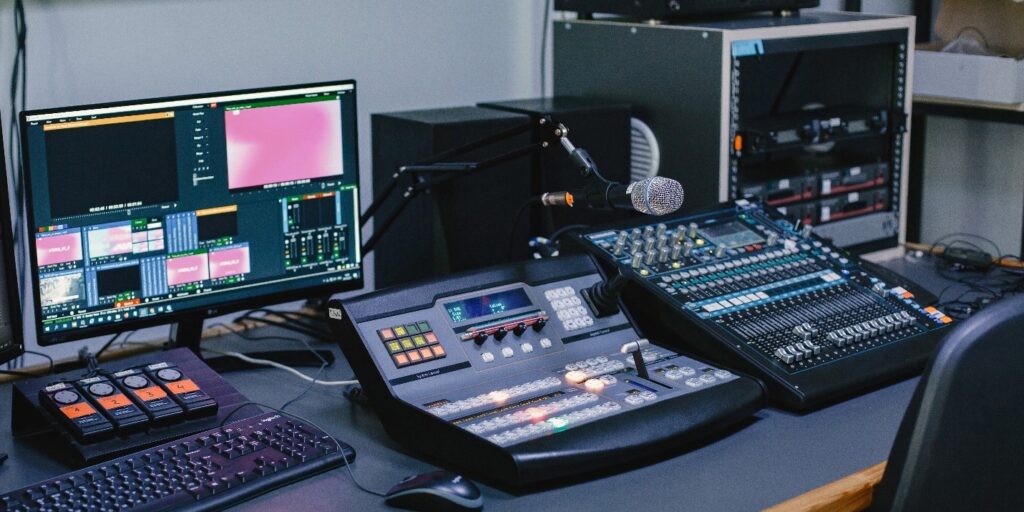 May 9, 2023 by thilina |
paid live streaming
May 9, 2023 by thilina |
paid live streamingIn today’s digital landscape, live streaming has become an essential tool for businesses of all sizes to reach their target audiences quickly and cost-effectively. However, as the popularity of live streaming grows, so does the competition. To remain competitive, many companies are now turning to paid livestreaming services that offer exclusive content and greater engagement potential with viewers. But what exactly does it mean to use a paid livestreaming service? And how can you leverage this powerful tool to reach new markets? This article will provide an overview of paid livestreaming services along with tips on optimizing your stream and reaching new markets.
Advantages of Paid Live Streaming for Businesses

One of the major advantages of using a paid livestreaming service is access to exclusive content that viewers may not be able to find elsewhere. For example, if you are hosting a webinar about your product or service, creating private pay-per-view events can lead to higher-quality leads since people have already taken steps towards purchasing something from you before ever attending your event. Additionally, having a paywall forces viewer to commit more time and effort in order to attend, which also means they’re more likely to be invested in seeing real results from their experience—making them more likely to become customers.
The Benefits of Investing in Professional Live Streaming Services
When using livestream for business purposes, it is important to invest in professional live streaming services. This will ensure that you have access to the right tools and expertise needed to set up a successful stream, as well as someone who can troubleshoot any potential issues that may arise during the production process. Professional livestreaming services also allow you to take advantage of features like custom branding, virtual sets, and higher-quality audio, which can all help create an even more engaging viewing experience for your audience, resulting in stronger relationships with viewers and prospects alike.
Challenges of Setting Up a Professional Live Stream Production

Despite its many benefits, setting up a professional live stream production does come with some challenges, such as selecting the appropriate hardware and software setup depending on the type of content you are producing and finding reliable sources for supporting equipment such as cameras or audio mixing desks, if necessary. Additionally, learning how to effectively use these tools in order to present your content successfully is another challenge that needs consideration when creating a paid livestreaming event. Lastly, ensuring that your internet connection is stable enough so that technical problems don’t occur during your broadcast should always be one of your top priorities.
Tips to Optimize Your Paid Live Stream
When it comes to optimizing your paid campaigns, there are several strategies and best practices you should consider implementing:
• Firstly, invest in the right equipment and technology (e.g., professional video cameras, mixing desks, etc.) that are necessary for creating high-quality content.
• Secondly, make sure you have a backup plan in case something happens during the broadcast—this could mean having someone on site that can troubleshoot any potential technical issues or using an external platform like Twitch as an additional streaming option if needed.
• Thirdly, create promotional materials ahead of time, such as banners or social media posts, so viewers know when and where they can watch your livestream.
• Lastly, review all audio levels before going live to ensure the sound quality is up to par with industry standards. This will ensure that viewers don’t experience any problems understanding what’s being said during your stream.
Understanding the Difference Between Free and Paid Live Streaming Services
When deciding whether to use free or paid livestreaming services for your business needs, it’s important to understand the difference between them first. Generally speaking, free services are more limited in terms of features and accessibility; for example, you are limited to certain streaming platforms such as YouTube or Twitch, and most of these services don’t offer customizable options like virtual sets or monetization tools. On the other hand, paid live streaming services provide more flexibility with regards to content creation, support for multiple platforms (e.g., Facebook Live), customization options, and audience growth potential—all of which can be very beneficial for businesses looking to create a professional online presence and reach new markets.
Tips for Improving Audio Quality When Livestreaming
Audio quality is one of the most important aspects when creating livestream. Poor audio can make it difficult for viewers to understand what’s being said during the broadcast, resulting in confusion that could potentially turn prospects away from your business altogether. Luckily, there are several techniques that you can use in order to improve audio quality when preparing a paid livestream:
- Invest in high-quality audio equipment, such as external microphones and mixing desks, that will give you control over sound levels during your broadcasts.
- If using an onsite microphone instead of an external one, make sure you place it close enough to your subject but far enough away so background noise doesn’t interfere with the recording.
- Utilize noise reduction techniques, such as using acoustic foam or a designated quiet room, to eliminate any unwanted background noises.
- Finally, ensure that you have the proper software installed and configured in order to edit and mix audio levels before going live.
Best Practices for Promoting Your Paid Livestreams
In order to get the most out of your paid livestreaming efforts, it is important to create an effective promotion strategy. This should include activities such as posting about upcoming events on social media platforms and creating email campaigns, but there are also other strategies you can employ for maximum results:
- Utilize influencer marketing by partnering with industry specialists who already have an established following; this can help grow your audience quickly.
- Leverage the advertising tools offered by streaming platforms like YouTube or Twitch that allow you to target specific groups of viewers based on their interests.
- Consider providing discount codes or free previews of your content in order to generate interest ahead of time.
- Make sure all promotional materials reflect the same branding elements so viewers are clear on what they’re signing up for when watching your stream.
Leveraging Social Media Platforms for Your Livestream Audience Engagement
Livestreaming is not only about delivering quality content; it’s also about engaging in conversations with viewers and fostering relationships that can lead to long-term customers. To do this, you should leverage social media platforms like Twitter, Facebook, and Instagram as a way to interact with your audience. This includes responding to questions, thanking them for watching, and even using polls or surveys during the broadcast itself in order to increase engagement. Additionally, you can use these platforms as an opportunity to promote upcoming streams or other related events, which will help grow your following over time.
Reaching New Markets Through Paid Livestreams
Livestreaming is an effective way for businesses to reach new markets; however, paid livestream provide even more opportunities due to their ability to offer exclusive content. By becoming familiar with the differences between free and paid services, understanding how professional live streaming services work, and implementing best practises when promoting your stream, businesses of all sizes can open up new avenues of growth by leveraging the power of paid livestreaming services.
FAQs:
The type of equipment needed for a successful paid livestream depends on what type of content you are producing—if you’re creating video and audio recordings, then investing in quality cameras and sound mixers is essential. Additionally, some livestreaming platforms require specialized software as well, so it is important to do your research ahead of time in order to make sure you have the right setup for your needs.
If you encounter any issues while setting up a professional live stream production, then it’s best to contact the technical support team of the streaming platform you are using—most companies will have someone who can help walk you through problems quickly and efficiently. Additionally, if possible, having someone onsite who knows how to troubleshoot potential technical issues can also be beneficial.
There are several strategies that businesses can use in order to monetize their stream, such as creating exclusive content for viewers or charging an entrance fee for attending paid events instead of offering them for free. Additionally, leveraging advertising networks like Google AdWords or YouTube Ads are other options depending on what type of content is being produced or where viewers are located geographically.
Many streaming services allow users to embed pre-recorded videos into their broadcasts; however, it is important to be aware of copyright laws when using existing video content, as many platforms have specific rules that must be followed in order to avoid any potential legal issues.
Yes, many streaming services support multi-location streaming, which provides businesses with a great deal of flexibility when creating their broadcasts. Additionally, some platforms also allow viewers to switch between different angles and perspectives while watching a single stream, which can create an even more dynamic viewing experience.
Yes—depending on what type of content you are producing or where your broadcast is being shown (e.g., on a website or mobile app), you may need to abide by certain copyright regulations, such as obtaining permission from the owner before embedding copyrighted material into your streams. It’s best practice to always check for these types of restrictions prior to beginning your broadcast, so you don’t run into any unexpected issues down the line.
There are several metrics that businesses should consider when measuring their success; this includes tracking viewership numbers over time and reviewing the amount of engagement each stream receives (e.g., comments, likes, shares). Additionally, monitoring any trends that appear in the data collected from these sources can help businesses create better content and optimize their streams for maximum results.
When evaluating 3D virtual studio set production services, it’s important to consider metrics such as video quality (e.g., framerate and resolution), lighting effects available, and the overall realism of the sets—all of which will have an impact on how viewers perceive your broadcast. Additionally, paying attention to viewer feedback after each broadcast is a great way to determine if any improvements need to be made in order for future events to be successful as well.
Yes, many streaming platforms offer embedding capabilities that allow users to embed their livestream into other websites or apps; however, depending on the service you are using, you may also need permission from both parties before doing this, so it’s important to read through their terms and conditions before taking any steps towards integrating any additional functionality into your broadcasts.
Whether it’s best to use one or multiple streaming services depends on the type of content you are creating and where your target audience is located. For example, if you’re aiming to reach viewers in Asia, then using a platform that specializes in this region would be beneficial; however, if you’re looking for a more global approach, then leveraging both major services like YouTube or Twitch as well as regional ones can help broaden your reach significantly.
